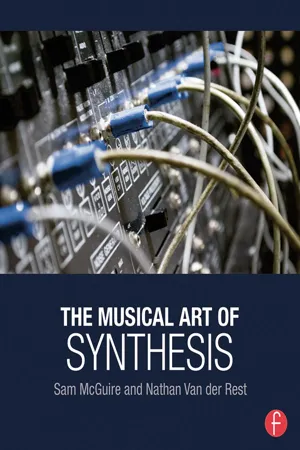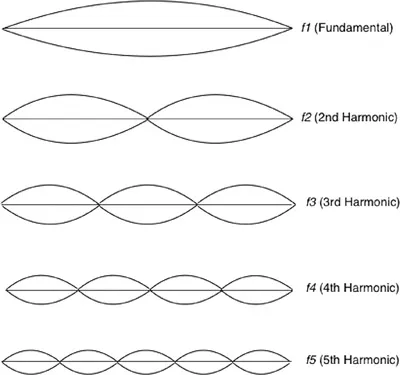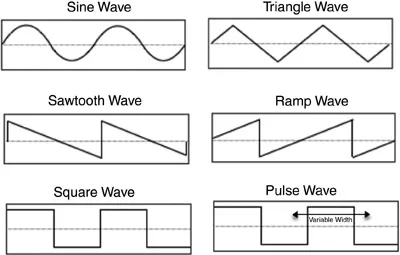![]()
Subtractive synthesis has been used on thousands of records, and, in spite of its continued evolution, its essence remains the same at the very core. The reason it has continued to inspire musicians is because it can take electronic sounds and give them life through filters and envelopes that breath motion into the lifeless in order to create new, organic, exciting sounds or mimic the natural organic progression of acoustic instruments. Sounds are nothing less than magical when programmed by the experienced user.
The Synthesizer Database
When conducting research for this book, we thought it would be interesting to examine as many of the commercially available synthesizers that was physically possible in order to come up with averages of their capabilities. We compiled a comprehensive database that featured as many synths as possible (around 800 individual instruments) and outlined, in depth, their functionality. We examined things like the number of oscillators and low frequency oscillators, the number of filters and filter shapes, the number of envelope generators and their capabilities, the various wave shapes the synth could produce, the modulation routings, and the inclusion of various forms of performance control. We then averaged this database in relation to synthesis format so that we could provide you with the average number of synthesizers that feature a specific parameter throughout this chapter. As you will see in the coming pages, each parameter of subtractive synthesis will be complimented with the average percent of synthesizers that feature that particular function. So without further ado, let’s begin with subtractive synthesis.
Subtractive synthesis starts with a sound. This sound is then filtered, modulated, mangled, and mashed, resulting in something beautiful. The starting sound comes from what is known as an oscillator, which is the heart of any synthesizer. Often underrated, the design of a synthesizer’s oscillator ultimately determines the status that a synthesizer holds in history. Every parameter on a subtractive synthesizer—be it a filter, an envelope generator, a low frequency oscillator (LFO), or an amplifier—relies on the oscillator or oscillators in order to stand out amongst the vast and ever growing market of synthesizers. Take a MiniMoog for example; just listening to a single oscillator playing a triangle wave with no envelopes, resonance, or modulation is enough to send shivers down someone’s spine. An average triangle wave is rather boring, but, for some reason, a MiniMoog’s triangle wave connects with its users and instantly inspires them to reach out and turn every knob, opening up a world of creativity. The fact that every single waveform on a MiniMoog elicits this same response is the very reason that the MiniMoog became one of the most famous subtractive synthesizers in history.
Based on the information collected, subtractive synthesizers feature three oscillators on average.
So what makes an oscillator so iconic? The functionality and features of an individual oscillator definitely play a role, but the sound of the individual waveforms an oscillator creates is where its iconic status ultimately rests. Let’s examine what makes up a waveform as well as what makes a sawtooth wave sound different from a triangle or a square wave.
Harmonics
A waveform consists of a fundamental frequency and a series of additional frequencies called harmonics. The fundamental frequency is the frequency of the note being played. For example, the middle “A” note has a fundamental frequency of 440Hz, but most instruments do not produce just a single frequency. When a pianist strikes the middle “A” note on a piano for example, 440Hz is not the only frequency that is heard. Many higher frequencies, called overtones, emit from the piano as well. In a piano, these overtones are caused by the way the string vibrates, the resonance of the body of the piano, and other strings resonating in conjunction with the string being struck. The frequencies above 440Hz that emit from a piano when the middle “A” is struck are multiples of the fundamental frequency; these are called harmonics. The harmonics are produced in what is called the harmonic series, which is a pattern of harmonics that occurs naturally with musical instruments. In the harmonic series, the first harmonic is the fundamental frequency. Using our “A” 440 example, 440Hz is the first harmonic of the harmonic series. The second harmonic is twice the fundamental, or 880Hz. The third harmonic is three times the fundamental, or 1320Hz, etc.
Although the harmonic series is present in every instrument or sound, the amplitude at which these harmonics are heard vary from one instrument to another due to the material the instrument is made of, as well as the way in which sound is generated (strings, resonant tubes, membranes, etc.). These differences explain why instruments have unique sounds; a piano sounds different from a tuba which sounds different from an accordion and so on and so forth. This difference in tonal quality is called timbre. Synthesizers are such an attractive instrument because they can change timbres in an instant. The user is free to emulate a natural instrument or make a sound that is so earth shattering that it questions the very meaning of what is musical, all with the turning of a few knobs.
Figure 1.1 The harmonic series as demonstrated with vibrating strings.
Waveforms
When dealing with synthesizers, each waveform has a unique sound due to the varying harmonic content that is produced. This is why a square wave sounds worlds apart from a sine wave. Let’s take a look at the harmonic content of the most common waveforms found in subtractive synthesis in order to better understand the tonal quality of each of these waveforms.
Sine waves are the most simple of the waveforms. They contain only the fundamental frequency and no harmonics. A sine wave is something that is unique to synthesis because there are no nonelectronic instruments capable of such a tone. Just because a sine wave is simple does not mean that it is boring or less than useful. A sine wave, when placed in the audio spectrum correctly, will rumble the floors of a venue or pierce through the densest of mixes.
Figure 1.2 The standard synthesis wave shapes.
Take a Roland TR 808 drum machine for example. The 808 uses analog subtractive synthesis to create its drum sounds. The iconic kick drum sound of an 808 has destroyed subwoofers and left an everlasting impression on anyone who has heard it thanks to its huge sine wave “ring” on the falling end of its sound. Sine waves have also long been coveted as a foundation for the largest of synth bass sounds. The extremely memorable bass sound on Nine Inch Nail’s “Closer” would not have been possible without a sine wave in the mix.
Based on the information collected, 34% of subtractive synthesizers feature audio oscillator sine wave generation.
Triangle waves sound fairly similar to sine waves but with a bit more harshness. A triangle wave contains the fundamental frequency as well as all odd harmonics. This means that a triangle wave is made up of the first harmonic, or fundamental frequency, the third harmonic, the fifth harmonic and so on. The rate at which the higher harmonics drop in amplitude is proportionate to the inverse square of the harmonic number. For example, the third harmonic is 1/9th the amplitude of the fundamental and the fifth harmonic is 1/25th the amplitude of the fundamental. This rapid decline in the amplitude of the harmonics causes very few harmonics to be audible, which is why the triangle wave sounds similar to the sine wave. The few harmonics that are audible separate the triangle wave from the sine wave. As stated earlier, the MiniMoog’s triangle wave is one of the many reasons the MiniMoog is still being talked about today. When overdriven into a filter, the triangle wave adds everything a sine wave is capable of adding to a sound, but also adds a new dimension of grit and glam that is only attainable through this means of synthesis.
Based on the information collected, 48% of subtractive synthesizers feature audio oscillator triangle wave generation.
Sawtooth waves have a very distinct, raspy sound quality. A sawtooth wave can scream and it pierces through any sound it’s up against. At the same time, however, a sawtooth can be filtered back to create soft, delicate, and smooth sounds that can be placed in the most “moody” of R&B songs. Sawtooth waves get their name from their resemblance of a physical sawtooth when viewed on an oscilloscope. Unlike a triangle wave, a sawtooth wave contains the fundamental frequency as well as both even and odd harmonics. The rate at which the harmonics drop in amplitude is inversely proportionate to the fundamental rather than the inverse square of the fundamental like in a triangle wave. This means that the second harmonic is 1/2 the amplitude of the fundamental, the third harmonic is 1/3 the fundamental, the fourth harmonic is 1/4 the fundamental and so on. Due to the slower decline in amplitude of the harmonics as well as having the even and odd harmonics audible, the sawtooth wave is extremely rich sounding and is very useful in subtractive synthesis. Due to the rich and harsh tonal quality of the sawtooth wave, it is extremely well suited for re-creating bowed string sounds such as cellos and violins and, as stated earlier, piercing lead and punchy bass synth sounds. The sawtooth wave is a staple amongst synthesizers and no instrument besides a synthesizer can come close to re-creating it.
Based on the information collected, 68% of subtractive synthesizers feature audio oscillator sawtooth generation.
Ramp waves, or reverse sawtooth waves, are simply backwards sawtooth waves. Rather than the wave peaking and then sharply sloping down, the ramp wave sharply slopes up and then peaks and drops back down to zero. The ramp wave contains the exact same harmonic content as the sawtooth and sounds identical. However, it is when using the oscillator as a control source for an LFO or as an envelope that ramp waves differentiate themselves from sawtooth waves and become one of the most overlooked and coveted of the waveforms. Mark Mothersbaugh of DEVO sent his MiniMoog back to the engineers at Moog in order to have it customized in order to produce a ramp wave. Mark’s customized MiniMoog can be heard in the extremely memorable synth parts of DEVO’s “Smart Patrol/Mr. DNA.”
Based on the information collected, 41% of subtractive synthesizers feature audio oscillator ramp wave generation.
Next to sawtooth waves, square waves are the most recognizable of the waveforms. Square waves have a rich but hollow sound quality. Their name is derived from their square-like appearance on an oscilloscope. Like the triangle wave, square waves are made up of the fundamental frequency as well as all odd harmonics meaning they contain the first harmonic (fundamental), third harmonic, fifth harmonic, and so on. Unlike a triangle wave however, the rate at which the harmonics drop in amplitude are inversely proportionate to the fundamental. This means that the third harmonic is 1/3 the amplitude of the fundamental, the fifth harmonic is 1/5th the fundamental, the seventh is 1/7th the fundamental and so on. Because of the square wave’s richer sonorities of harmonics, it imparts a full tonal quality to any synth sound that can only be described as legendary. Keith Emerson’s synth solo towards the end of Emerson, Lake & Palmer’s “Lucky Man” are perfect examples of what a square wave can add to a screaming lead line. The alternative band Passion Pit makes extensive use of the square wave on most of their synth parts throughout their entire catalog of music. The square wave is truly a synth staple and, for that reason, it can be found on almost 99% of synthesizers from the most basic and budget models up to the most expensive.
A pulse wave is, in essence, a variable square wave. Like a square wave, the pulse wave contains the fundamental and all odd harmonics with the same inversely proportionate harmonic amplitude drop. The difference is that the width of the wave in the positive and negative direction is variable. One of the most sonically pleasing and sought after sounds in synth history is created b...


